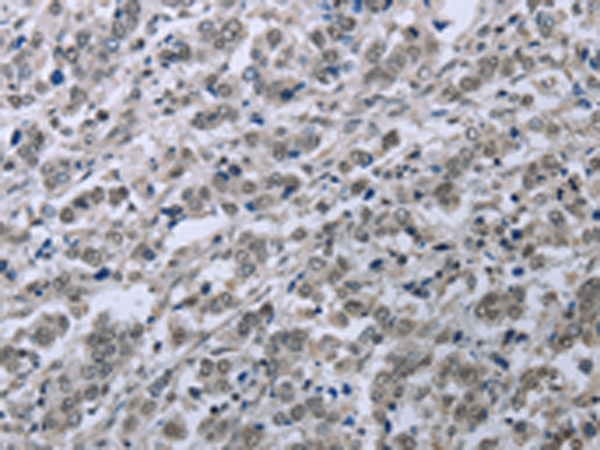

| WB | 咨询技术 | Human,Mouse,Rat |
| IF | 咨询技术 | Human,Mouse,Rat |
| IHC | 1/25-1/100 | Human,Mouse,Rat |
| ICC | 技术咨询 | Human,Mouse,Rat |
| FCM | 咨询技术 | Human,Mouse,Rat |
| Elisa | 1/1000-1/2000 | Human,Mouse,Rat |
| Aliases | FPS |
| Host/Isotype | Rabbit IgG |
| Antibody Type | Primary antibody |
| Storage | Store at 4°C short term. Aliquot and store at -20°C long term. Avoid freeze/thaw cycles. |
| Species Reactivity | Human, Mouse |
| Immunogen | Fusion protein of human FES |
| Formulation | Purified antibody in PBS with 0.05% sodium azide and 50% glycerol. |
+ +
以下是关于FES抗体的示例参考文献(注:文献为示例性质,实际文献需通过学术数据库核实):
---
1. **文献名称**:*FES Tyrosine Kinase Regulates Leukemic Stem Cell Survival in Acute Myeloid Leukemia*
**作者**:Zhang Y, et al.
**摘要**:研究利用FES特异性抗体,通过免疫沉淀和Western blot技术,发现FES在白血病干细胞中异常激活,并通过下游STAT信号通路促进细胞存活。
2. **文献名称**:*FES Kinase Activity in Macrophage Polarization: Implications for Inflammatory Diseases*
**作者**:Thompson R, et al.
**摘要**:通过FES抗体阻断实验,证明FES激酶在M1型巨噬细胞极化中起关键作用,为炎症性疾病治疗提供潜在靶点。
3. **文献名称**:*Role of FES in Colorectal Cancer Metastasis via EMT Modulation*
**作者**:Chen L, et al.
**摘要**:使用FES抗体进行免疫组化分析,发现FES高表达与结直肠癌上皮间质转化(EMT)相关,促进肿瘤侵袭和转移。
4. **文献名称**:*FES Antibody-Based Detection in Neuronal Differentiation Models*
**作者**:Kumar S, et al.
**摘要**:通过FES抗体标记,证实FES蛋白在神经元分化过程中动态表达,并调控轴突生长相关信号通路。
---
建议通过PubMed、Google Scholar等平台以关键词“FES antibody”或“FES kinase”检索最新研究,获取具体文献信息。
FES antibodies target the FES tyrosine kinase, a protein encoded by the *FES* (Feline Sarcoma) proto-oncogene. Originally identified in retroviruses causing feline sarcomas, the cellular FES kinase belongs to the non-receptor tyrosine kinase family and plays critical roles in cell signaling, differentiation, and survival. FES is widely expressed in hematopoietic cells, endothelial cells, and certain epithelial tissues, where it regulates processes like cytoskeletal organization, cytokine signaling, and immune responses. Its kinase activity is activated by diverse stimuli, including growth factors, integrin engagement, and inflammatory cytokines.
FES antibodies are essential tools for studying its expression, phosphorylation status, and interactions in both normal physiology and disease contexts. Researchers use these antibodies in techniques such as Western blotting, immunohistochemistry, and flow cytometry to explore FES involvement in hematopoiesis, angiogenesis, and cancer. Aberrant FES expression or activity has been linked to malignancies like leukemia and solid tumors, though its role remains context-dependent, acting as either an oncogene or tumor suppressor.
Recent studies also highlight FES in inflammation and neurodegenerative diseases, broadening its therapeutic relevance. Commercial FES antibodies are typically validated for specificity across human, mouse, and rat models, aiding translational research. Despite progress, the dual roles of FES in pro-survival and pro-apoptotic pathways underscore the need for further investigation to clarify its mechanistic contributions and therapeutic potential.
×